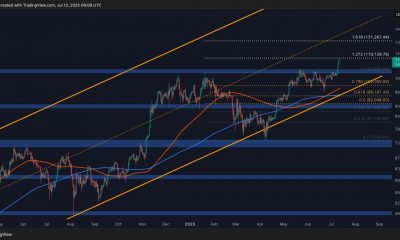Forex
Inflation rate euro area slowed down to 9.2% in December and to 10.4% in EU

Inflation rate in the euro area in December 2022 rose by 9.2% compared to the same month in 2021, according to the final data from Eurostat. This is the lowest inflation rate in four months. The rate of increase in consumer prices in the bloc has slowed down from a record 10.1% in November. The final data matched preliminary data. Analysts polled by Trading Economics did not expect the euro inflation rate forecast to be revised. Compared with the previous month prices in the euro area fell by 0.4%.
Consumer prices, excluding such volatile factors as energy, food, and alcohol (CPI Core Index, tracked by the European Central Bank), rose 5.2% year on year last month after rising 5% a month earlier.
Food, alcohol and tobacco prices rose 13.8% after rising 13.6% in November. The rise in energy prices slowed to 25.5% after a 34.9% increase a month earlier. Services became more expensive by 4.4%.
In 27 EU countries, prices in annual terms rose by 10.4% in December after an increase of 11.1% a month earlier. Against the previous month, prices in the EU decreased by 0.2%.
The lowest inflation in annual terms in December was observed in Spain (5.5%), Luxemburg (6.2%) and France (6.7%). The highest growth in consumer prices was recorded in Hungary (25.0%), Latvia (20.7%) and Lithuania (20.0%).
In Germany, annual inflation slowed down to 9.6% from 11.3% in November. In Italy – to 12.3% from 12.6% a month earlier
Earlier we reported that the share of the euro in international settlements decreased for the second year in a row by the end of December.

 Forex3 years ago
Forex3 years agoForex Today: the dollar is gaining strength amid gloomy sentiment at the start of the Fed’s week

 Forex3 years ago
Forex3 years agoUnbiased review of Pocket Option broker

 Forex3 years ago
Forex3 years agoDollar to pound sterling exchange rate today: Pound plummeted to its lowest since 1985

 Forex3 years ago
Forex3 years agoHow is the Australian dollar doing today?

 Cryptocurrency3 years ago
Cryptocurrency3 years agoWhat happened in the crypto market – current events today

 World3 years ago
World3 years agoWhy are modern video games an art form?

 Commodities3 years ago
Commodities3 years agoCopper continues to fall in price on expectations of lower demand in China

 Economy3 years ago
Economy3 years agoCrude oil tankers double in price due to EU anti-Russian sanctions



























